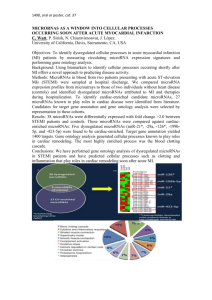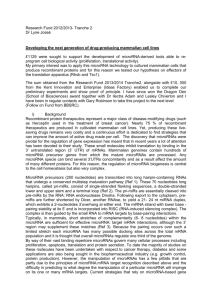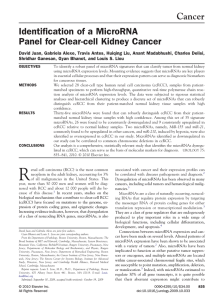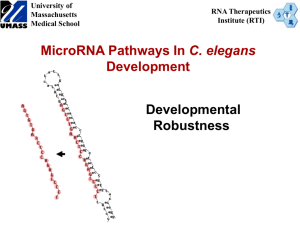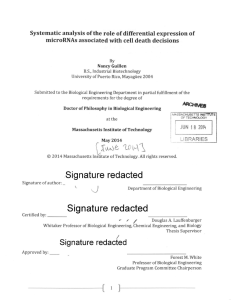PowerPoint - Q-CROC
advertisement
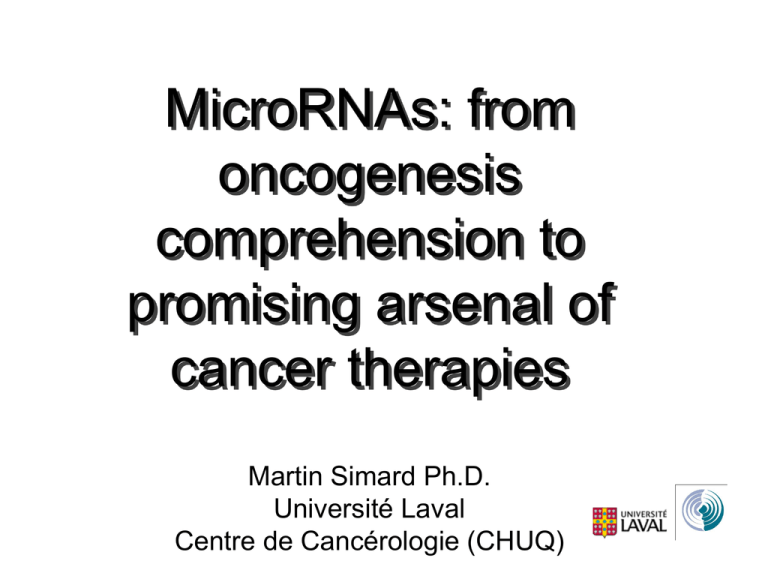
MicroRNAs: from oncogenesis comprehension to promising arsenal of cancer therapies Martin Simard Ph.D. Université Laval Centre de Cancérologie (CHUQ) microRNAs: A new class of regulatory molecules •Small non-coding RNAs (21 to 23 nucleotides long) •First discovered in Caenorhabditis elegans •Found in nearly all eukaryotes more than 1,000 different microRNAs in human •Act “negatively” in gene expression and control cellular timing •Recent estimation support that more than 60% of the human coding genome is How microRNAs are produced? • • • • Mainly produced by RNA polymerase II. 1st maturation in the nucleus 2nd maturation in the cytoplasm Nature Reviews MCB, 2008 Active complex: miRISC How microRNAs work? • • • Partial complementarity with 3’UTR regions (position 2 to 8 critical) Cooperative effect Abrogate protein synthesis Nature Reviews MCB, 2008 One microRNA may regulate up to 100 different genes! Precise expression profile miR-1-1 miR-1-2 Zhao et al, Nature 2005 Pena et al, Nature Methods 2009 Implication in cell differentiation Stefani and Slack, Nature Reviews MCB 2008 Precise expression profile: haematopoiesis Gangaraju and Lin, Nature Reviews MCB 2009 The loss of microRNAs lead to fatality Zhao et al, Cell 2007 Loss of miR-1-2 leads to overproduction of muscle cells Ventura et al, Cell 2008 Loss of miR-1792 cluster is embryonic lethal microRNAs and Cancer microRNAs are frequently located in altered genomic regions associated to various cancers Calin et al, PNAS 2004 microRNAs and Cancer Different expression profile between healthy and cancer tissue samples Lu et al, Nature 2005 microRNAs and Cancer • Oncogenes Oncogene 2006 microRNA as Oncogene : miR-10b • • • Overexpression increases angiogenesis Induces metastasis formation Correlation between miR-10b overexpression and metastatic tumours caused by breast cancer Ma et al, Nature 2007 microRNAs and Cancer • Oncogenes • Tumour suppressors Oncogene 2006 microRNA as Tumour suppressor : let-7 • • • let-7 level is altered in lung cancer let-7 controls RAS expression HMGA2 is another target of let-7 Mayr et al, Science 2007 Johnson et al, Cell 2005 microRNA as Tumour suppressor : miR-335 and miR-126 • • • Re-establishing their expressions diminish the metastasis formation miR-335 controls cell migration miR-126 controls cell proliferation Tavazoie et al, Nature 2008 Implication of the p53 p53 miR-34 BCL2 Survival CDK6 CDK4 CyclinE2 Cell proliferation He et al. Nature 2007 (+4) Implication of the p53 p53 miR-34 BCL2 CDK6 CDK4 CyclinE2 miR-16-1 miR-145 miR-143 Survival Cell proliferation He et al. Nature 2007 (+4) Suzuki et al. Nature 2009 microRNAs and Cancer: more and more examples Mutation or epigenetic changes can lead to: • Deletion of microRNA miR-15a,-miR16-1 silencing of microRNA locus • Epigenetic miR-29, miR203 • Point mutation affecting a microRNA or microRNA precursor miR-15a,-miR16-1 • miR-17~92, Genomic amplification or translocation of microRNA locus miR21 • Loss of epigenetic silencing of microRNA locus • Point mutation in the microRNA targets • Rearrangement of 3’UTR HMGA2 Spizzo et al, Cell 2009 microRNA as a Cancer therapy: miR-26a Decrease in tumour mass Kota et al. Cell, 2009 New therapies: Controlling microRNA expression Science, 2008 Controlling microRNA expression: different methods Garzon et al, Nature Reviews Drug Discovery, 2010 Why microRNA are functionally important in primary cancers? •There are tumours-specific microRNA signatures which accurately distinguish different sub-types of cancers •Modulation of microRNAs in cancer cell lines can directly regulates fundamental behaviours of cancer cells such as proliferation and apoptosis •Many microRNAs deregulated in cancers have been shown to control oncogenes, tumour suppressors and signalling pathway components as direct targets microRNAs and Cancer: new biomarkers Nature Biotechnology 2008 microRNAs and Cancer: new biomarkers PNAS, 2007 Using ovarian cancer as a model, we demonstrate that expression of let-7 and HMGA2 is a better predictor of prognosis than classical markers such as E-cadherin, vimentin, and Snail. These data identify loss of let-7 expression as a marker for less differentiated cancer. British J. of Surgery, 2009 microRNAs and Cancer: new biomarkers to predict drug resistance Clinical Cancer Research, 2009 Why microRNA are excellent biomarkers? •Extremely stable in fluids as well as on formalinfixed paraffin-embedded tissue •Expression profile correlates well between fresh and formalin-fixed paraffin-embedded samples •Resistant to degradation Why microRNA are excellent biomarkers? Weber et al, Clinical chemistry, 2010 Our microRNA profiling platform TaqMan based quantitative RT-PCR Our microRNA profiling platform •Extremely sensitive (from 10 cells) •Great specificity •No hybridization required •Easily go from profiling to validation let-7a let-7b UGA GGU AGU AGG UUG UAU AGU U UUG UGU GGU UGA GGU AGU AGG let-7d U UUG UAU GGU UGA GGU AGU AGG U AGA GGU AGU AGG UUG CAU AGU let-7e UGA GGU AGG AGG UUG UAU AGU let-7c microRNAs are associated to various diseases • Viral infections - Viruses encodes microRNAs that target viral mRNAs to regulate various stages of the viral life cycle - Viral microRNAs suppress expression of specific host genes - Viral infections induce expression of host microRNAs that inhibits expression of cellular genes - Upon viral infections, host cells express specific microRNA that suppress viral mRNA expression • Cardiac, immune, neurological and metabolic disorders To summarize microRNAs: A new class of regulatory molecules •Small non-coding RNAs (21 to 23 nucleotides long) •First discovered in Caenorhabditis elegans More than found in 142 •Found in 17,000 nearlymicroRNAs all eukaryotes species! •microRNA as new biomarkers •Modulation of microRNA expression: new therapeutic strategy Fundamental research: Questions to be answered • What are the targets of microRNAs? • How microRNA expression is regulated? • How microRNAs regulate gene expression? • Which are the cellular factors implicated in the microRNA pathway? Translational research: What we can do as collaborators Implication of miR-204 in pulmonary arterial hypertension A collaboration with Sebastien Bonnet us microRNA profiling from tissues you Identification of microRNA targets Functional test in animal models Journal of Experimental Medicine, in revision Take home message Stop thinking about DNA... ... think about RNA! Acknowledgments The Lab Collaborators Guillaume Jannot Samir Bouasker Gyorgy Hutvàgner, Dundee University Jean-Yves Masson, Université Laval Sébastien Bonnet, Université Laval Ivan Robert Nabi, UBC Dinshaw Patel, SloanKettering Eric Miska, Cambridge University Michael Hengartner, Zurich University Craig Mello, U. Mass Med. School Victor Ambros, U. Mass, Med. School Alejandro Vasquez Gabriel Bossé Irfan Syed Bukhari Johannie Ducharme Sandra Piquet Isabelle Banville Marie-Eve Boisvert Evelyne Rondeau Nellie Giguère Eric Paquet, CRC

